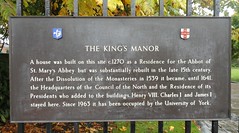King James I of England


King James I of England
(1566-1625)
King of Scots (1567-1625) and King of England (1603-1625)
Family tree
Commemorated on 3 plaques
The King's Manor. A house was built on this site c.1270 as a Residence for the Abbot of St. Mary's Abbey but was substantially rebuilt in the late 15th century. After the Dissolution of the Monasteries in 1539 it became, until 1641, the Headquarters of the Council of the North and the Residence of its Presidents who added to the buildings. Henry VIII, Charles I and James I stayed there. Since 1963 it has been occupied by the University of York.
Exhibition Square, York, United Kingdom where they stayed
Thorpe Prebend House. Restored 1609. King James I slept here 1617.
High Saint Agnesgate, Ripon, United Kingdom where they slept
Dunfermline Palace. Probably built in the 13th century, originally as a guest house of the Abbey, became a Royal Palace for Scotland's Kings and Queens. In the 16th century, alterations and additions were commissioned by King James VI and Queen Anne. The Palace was the birthplace of many royals, including King Charles I in 1600, a son of James VI and Queen Anne and a daughter, Princess Elizabeth in 1596, Grandmother of George I, the first Hanoverian King and the ancestor of the present Royal Family.
Dunfermline Palace & Abbey (ruins), Dunfermline, United Kingdom where they lived



